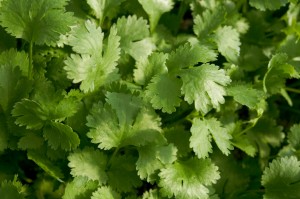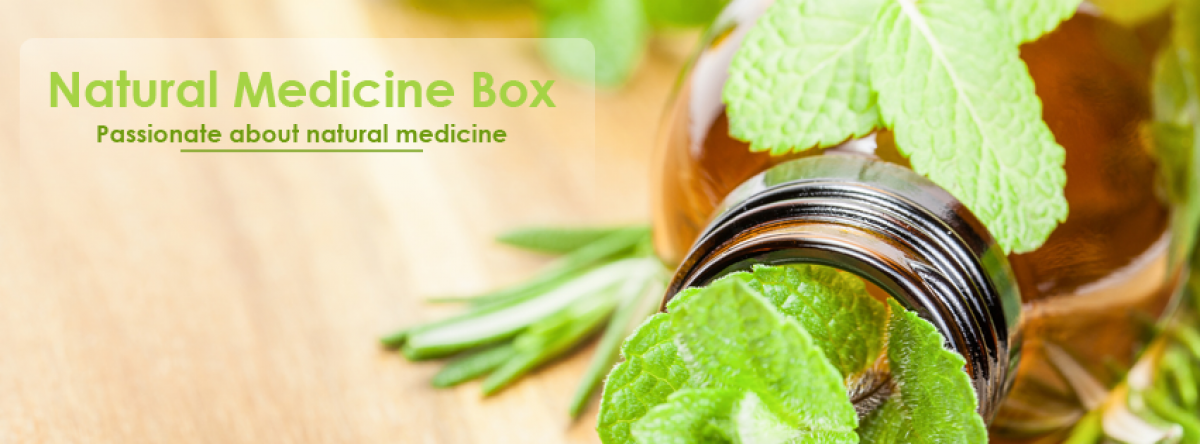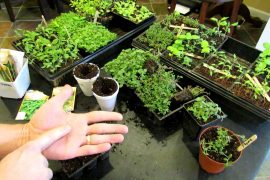6. Cilantro / Coriander
 Cilantro is high in antioxidant vitamin C, as well as several vitamins and minerals. It is also a revitalizing herb that aids with digestion and relieves inflammation that may cause gastric upset. Coriander seeds are known to have a positive impact on blood sugar, reducing stress in the liver and pancreas which promote better production of insulin as well as improved digestion.
Cilantro is high in antioxidant vitamin C, as well as several vitamins and minerals. It is also a revitalizing herb that aids with digestion and relieves inflammation that may cause gastric upset. Coriander seeds are known to have a positive impact on blood sugar, reducing stress in the liver and pancreas which promote better production of insulin as well as improved digestion.
The powerful flavor and aroma of Cilantro makes an excellent seasoning for meats, salsas, and Caribbean dishes. Coriander seed adds a warm spicy flavor to chicken, vegetables, and soups. For more about cooking with coriander seeds, read this article.
Grow your own cilantro and coriander by sowing seeds directly outdoors during spring and summer. Once flower buds develop, leaves will become scarce. Harvest cilantro leaves as available and allow to re-sow from coriander seeds that drop from harvested plants to continue growing throughout the season. Harvest coriander by clipping dried brown seed stalks and placing them upside-down in a brown paper bag. After a few days, seed pods will split and release coriander seeds.
Remember to keep your cilantro tidy. Clean up any spent leaves or other debris from around plants to prevent fungal infections. Also, keep an eye out for parasites like aphids which enjoy munching on tender young cilantro stems.
7. Lavender
 Lavender is one of the most useful andversatile herbal remedies, especially when its natural oils are distilled from the plant. Lavender can also be used as a seasoning and for baking.
Lavender is one of the most useful andversatile herbal remedies, especially when its natural oils are distilled from the plant. Lavender can also be used as a seasoning and for baking.
Lavender is also a natural deterrent for mosquitoes and other garden pests.
Grow your own lavender from seed by sowing indoors, then transplanting outdoors in early spring. Lavender does not tolerate excessive moisture or humidity so it should be positioned at the top of a slope or high in a planting box. Lavender also does well in containers for this reason, also.
Lavender blooms in the summertime. To encourage flowering all season long, clip blooms regularly either for herbal use or to dead-head once they begin to wilt. Lavender also benefits from light pruning in the spring after the first new growth appears.
8. Sage
 Sage-infused tea is an effective herbal remedy to reverse greying of hair, reduce fever, and calm anxiety from brain and nervous disorders. Sage tea can also be used to soothe gastric ailments brought on by stress and to treat infections of the mouth and throat.
Sage-infused tea is an effective herbal remedy to reverse greying of hair, reduce fever, and calm anxiety from brain and nervous disorders. Sage tea can also be used to soothe gastric ailments brought on by stress and to treat infections of the mouth and throat.
For cooking, dried or fresh sage makes an excellent seasoning in sauces, poultry dressings, and many sausage recipes. Sage also produces edible flowers in the early summer which make an interesting addition to salads and desserts. Both sage leaves and flowers make excellent additions to herbal tea blends.
Grow your own sage from seed by sowing indoors, then transplanting outdoors in the spring. Sage may also be sown directly outside in the springtime. Sage may also be propagated from cuttings. During the first year of growth, harvest only lightly so roots can establish. For both leaves and flowers, allow sage to grow as normal. Harvest flowers when buds are almost fully open. To prevent flowering, simply trim new growth often and remove any buds that appear. Stop harvesting sage 2 months before first frost. Also, when grown as a perennial, sage should be pruned back in early spring – removing older woody branches to make room for young tender growth.



IMO posts like this are fantastic